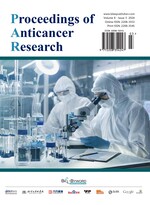Analysis of the Application Effect of Tracheal Stent Placement in the Nutritional Support Treatment of Tracheoesophageal Fistula
Abstract
Objective: To evaluate and analyze the application effect of tracheal stent placement in nutritional support therapy for tracheoesophageal fistula. Methods: Clinical data of 32 patients who underwent nutritional support therapy for tracheoesophageal fistula in our hospital from September 2021 to September 2022 were collected, and all patients underwent tracheal silicone stenting, comparing dyspnea classification and Karnofsky score before and after stenting, and conducting post-treatment follow-up. Results: In 32 patients with tracheoesophageal fistula, dyspnea grading improved from grades III and IV to grades 0 to II. Before treatment, 10 patients (31.06%) were in grade IV, 17 patients (53.12%) were in grade III, and five patients (15.62) were in grade II; after treatment, 13 patients (40.63%) were in grade I, 12 patients (37.50%) were in grade I, and seven patients (21.87%) were in grade 0 (P < 0.05); Karnofsky score (37.52 ± 4.86 before treatment) improved significantly to 71.39 ± 8.24 one week after treatment (P < 0.05). Nine patients with tracheoesophageal fistula were placed with silicone Y14-10-10 stent, 11 with silicone 18-14-14 stent, three with silicone Y15-12-12, and seven with silicone stent 16-13-13. Conclusion: Silicone tracheobronchial stent placement for the treatment of tracheoesophageal fistula is technically feasible, simple, and safe, with reliable near-term efficacy, and is worthy of popularization and application.
References
Wang T, Lai H, Hu H, et al., 2020, Comparison of the Effects of Gastrostomy and Stent Placement in the Treatment of Elderly Esophageal Cancer Patients with Dysphagia. Journal of Interventional Radiology, 29(09): 942–945.
Xu W, Jiang N, Zhang Q, et al., 2020, Prognostic Analysis of 124 Patients with Esophageal Cancer Accompanied by Esophageal Fistula and Exploration of Nutritional Support Mode. Journal of Clinical Oncology, 25(11): 999–1004.
Wang X, Huang H, Zhang W, et al., 2021, Application of Different Types of Congenital Heart Disease Sealers in Bronchopleural Fistula. Chinese Journal of Respiratory and Critical Care, 20(01): 37–41.
Bi Y, Yi M, Fu P, et al., 2019, Application of Fluoroscopic-Guided Removal of Coated Metal Endoprosthesis for Airway Fistulae. Journal of Zhengzhou University (Medical Edition), 54(05): 650–653.
Niu R, Han X, Wu G, et al., 2019, Evaluation of the Efficacy of Y-Shaped Self-Expanding Airway Laminating Stent for the Treatment of Thoracic Gastric-Right Main Bronchial Fistula After Esophagectomy for Esophageal Cancer. Journal of Zhengzhou University (Medical Edition), 54(05): 667–671.
Xie Z, Ke M, Chen Z, 2023, Field-Modified Metal Occluding Stent for Bronchopleural Fistula. China Interventional Imaging and Therapeutics, 20(11): 654–657.
Hu Y, Xiao Y, Yin W, et al., 2021, Clinical Application of Transrigid Bronchoscopic Metal Stent Implantation for the Treatment of Tracheo-Esophageal Fistula. Journal of Huazhong University of Science and Technology (Medical Edition), 50(03): 362–365 + 377.
Wang Y, Ning W, Wang Y, et al., 2022, A Case of Tracheoesophageal Fistula and Fundic Pleural Fistula After Esophageal Cancer Surgery Successfully Treated by Bronchoscopy Combined with Digestive Endoscopy. Chinese Journal of Respiratory and Critical Care, 21(02): 126–129.
Chen Y, Zhou Z, Feng J, et al., 2020, Analysis of the Efficacy and Safety of Using Intra-Airway Hybridization Stents for the Treatment of Complex Airway Stenosis and Airway Fistula. Chinese Journal of Lung Cancer, 23(06): 472–478.
Qing G, Deng T, Liu T, et al., 2024, Analysis of the Efficacy of Self-Expanding Metal Stent on Malignant Airway Disease and Factors Affecting Postoperative Survival. Chinese Journal of Respiratory and Critical Care, 23(02): 117–121.

